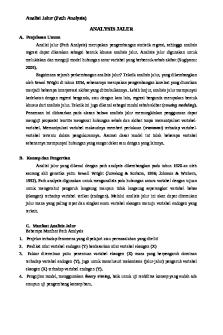Conducting a Path Analysis with SAS Proc Calis PDF

| Title | Conducting a Path Analysis with SAS Proc Calis |
|---|---|
| Course | Psychological Statistics |
| Institution | East Carolina University |
| Pages | 5 |
| File Size | 304.5 KB |
| File Type | |
| Total Downloads | 99 |
| Total Views | 148 |
Summary
Conducting a Path Analysis with SAS Proc Calis...
Description
Conducting a Path Analysis with SAS Proc Calis We shall use the data from the thesis published in this article: Ingram, K. L., Cope, J. G., Harju, B. L., & Wuensch, K. L. (2000). Applying to graduate school: A test of the theory of planned behavior. Journal of Social Behavior and Personality, 15, 215-226. The path model is:
Copy and paste the program boxed below into the SAS editor and then run it. options formdlim='-' nodate pagno=min; TITLE 'Path Analysis, Ingram Data' ; data Ingram(type=corr); INPUT _TYPE_ $ _NAME_ $ Attitude SubNorm PBC Intent Behavior; CARDS; N . 60 60 60 60 60 MEAN . 32.02 45.71 40.25 16.92 43.92 STD . 6.96 12.32 7.62 3.83 16.66 CORR Attitude 1 .472 .665 .767 .525 CORR Subnorm .472 1 .505 .411 .379 CORR PBC .665 .505 1 .458 .496 CORR Intent .767 .411 .458 1 .503 CORR Behavior .525 .379 .496 .503 1 Proc Calis PRINT; LINEQS Intent = b1 Attitude + b2 SubNorm + b3 PBC + E1, Behavior = b4 Intent + b5 PBC + E2; STD E1-E2 = V1-V2; run;
Explanation of the program. Rather than input the raw data, I have used correlation matrix input. The PRINT option in Proc Calis adds to the default output the total effects matrix (and some other things). To learn more about what the output options are for Proc Calis, click the help icon in SAS, select the “Index” tab, enter keyword “calis,” and click “Display.” Click “Syntax” and then “Proc Calis.” On the command bar, click “Edit,” “Find in this topic.” Enter “Displayed Output Options” and click “Next” twice.
Following the LINEQS statement the model is defined. The first equation indicates that Intent has paths to it from Attitude, SubNorm, PBC, and E1 (the error term); b1, b2, and b3 are the path coefficients that we want SAS to estimate for us. The second equation indicates that Behavior has paths to it from Intent, PBC, and E2. SAS assumes that the exogenous variables (Attitude, SubNorm, and PBC) are correlated. The STD statement asks that the error terms be estimated as parameters V1 and V2. The Output The Standardized Path Coefficients Standardized Results for Linear Equations Intent = Behavior =
0.8061 * Attitude + 0.0939 * SubNorm + -0.1255 * PBC + 1.0000 0.3491 * Intent + 0.3361 * PBC + 1.0000 E2
The Standardized Error Coefficients Standardized Results for Variances of Exogenous Variables Variable Standard Variable Parameter Estimate Type Error t Value Error
E1
V1
0.40058
0.08075 4.96056
E2
V2
0.65770
0.10019 6.56441
Standardized Coefficients Among Exogenous Variables Standardized Results for Covariances Among Exogenous Variables Estimate
Standard Error
t Value
_Add4
0.47200
0.10118
4.66473
Attitude
_Add5
0.66500
0.07262
9.15775
SubNorm
_Add6
0.50500
0.09699
5.20686
Var1
Var2
Parameter
SubNorm
Attitude
PBC PBC
E1
Standardized Direct, Indirect, and Total Effects Standardized Direct Effects Effect / Std Error / t Value / p Value Intent Attitude Behavior
PBC SubNorm
0.3491 0.1137 3.0693 0.002145
0
0.3361 0.1142 2.9445 0.003234
0
0
0.8061 0.0919 8.7690 .05, you conclude that the fit is good. Incremental Indices. These compare your model to an independence model (a model where all of the path coefficients are zero). The bigger the better. Bentler Comparative Fit Index 1.0000
A value below .9 is considered poor, .9 is considered marginal, .95 is good.
Bentler-Bonett Normed Fit Index 0.9936
A value below .9 is considered poor, .9 is considered marginal, .95 is good. Bentler-Bonett Non-normed Index 1.0461
A value below .9 is considered poor, .9 is considered marginal, .95 is good. If the value exceeds one, reduce it to one.
Links • Wuensch’s Stats Lessons • •
An Introduction to Path Analysis Adventures in Path Analysis
•
David Kenney on Fit Indices
Karl L. Wuensch Dept. of Psychology, East Carolina University, Greenville, NC 27858 USA April, 2016...
Similar Free PDFs

Old Path White Clouds Analysis
- 10 Pages

A WORN PATH Essay - A-
- 2 Pages

Estudio SAS - Apuntes programa sas
- 16 Pages
Popular Institutions
- Tinajero National High School - Annex
- Politeknik Caltex Riau
- Yokohama City University
- SGT University
- University of Al-Qadisiyah
- Divine Word College of Vigan
- Techniek College Rotterdam
- Universidade de Santiago
- Universiti Teknologi MARA Cawangan Johor Kampus Pasir Gudang
- Poltekkes Kemenkes Yogyakarta
- Baguio City National High School
- Colegio san marcos
- preparatoria uno
- Centro de Bachillerato Tecnológico Industrial y de Servicios No. 107
- Dalian Maritime University
- Quang Trung Secondary School
- Colegio Tecnológico en Informática
- Corporación Regional de Educación Superior
- Grupo CEDVA
- Dar Al Uloom University
- Centro de Estudios Preuniversitarios de la Universidad Nacional de Ingeniería
- 上智大学
- Aakash International School, Nuna Majara
- San Felipe Neri Catholic School
- Kang Chiao International School - New Taipei City
- Misamis Occidental National High School
- Institución Educativa Escuela Normal Juan Ladrilleros
- Kolehiyo ng Pantukan
- Batanes State College
- Instituto Continental
- Sekolah Menengah Kejuruan Kesehatan Kaltara (Tarakan)
- Colegio de La Inmaculada Concepcion - Cebu












